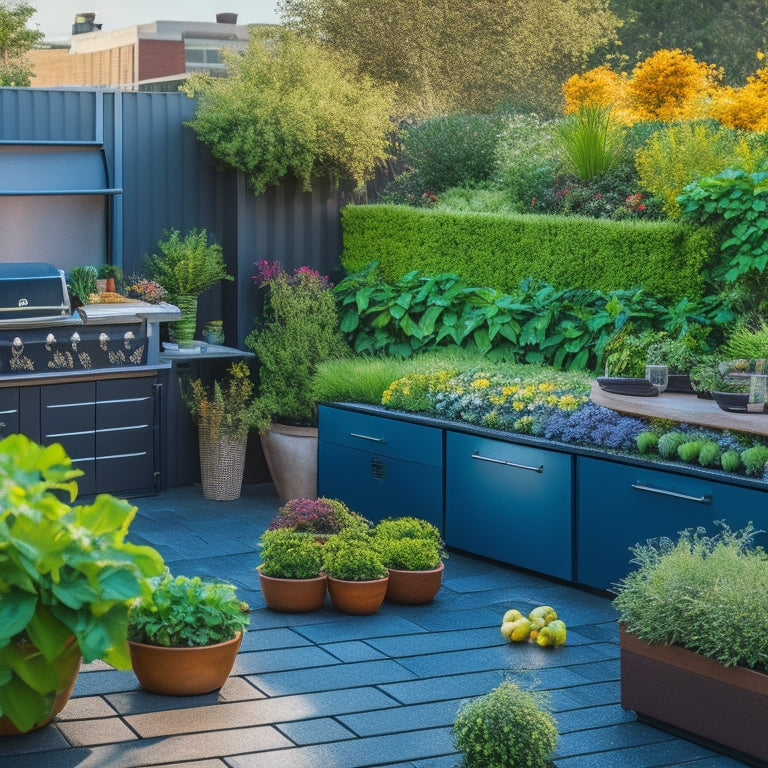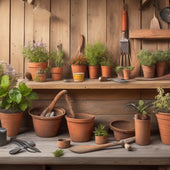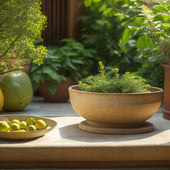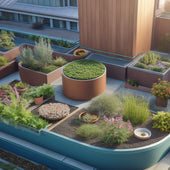
5 Rooftop Container Garden Layouts for Outdoor Kitchens
Share
You can turn your rooftop into a thriving outdoor kitchen with a container garden layout that suits your style. Consider the Compact Urban Oasis Design, which maximizes vertical space and incorporates a lush succulent display. Alternatively, the Linear Herb and Veggie Garden allows for efficient use of rectangular areas and utilizes trellises for vertical planting. The Tiered Planter Box Layout creates a multi-level garden, while the Rooftop Edible Border Garden transforms edging into a productive garden. Finally, the Modular Container Mosaic offers a customizable, visually striking design. Explore these options further to find the perfect blend of form and function for your rooftop oasis.
Compact Urban Oasis Design
By cleverly utilizing vertical space, you can create a compact urban oasis design that transforms your rooftop into a lush retreat, perfect for escaping the hustle and bustle of city life. This approach is ideal for small space landscaping, where every inch counts.
A vertical succulent display, for instance, can add visual interest while taking up minimal floor space. By incorporating a trellis or a living wall, you can further maximize your rooftop's vertical real estate.
Urban balcony gardening often requires creative problem-solving, and a rooftop oasis design is no exception. Consider using compact containers, like window boxes or hanging baskets, to create a verdant atmosphere. To guarantee your design remains cohesive, select plants with similar growing conditions and maintenance requirements.
Linear Herb and Veggie Garden
To create a Linear Herb and Veggie Garden on your rooftop, you'll need to designate a rectangular area with a consistent width and length, allowing you to grow a variety of herbs and veggies in a neatly organized, space-saving arrangement. This layout is ideal for rooftops with limited space, as it maximizes the use of your available area.
Start by dividing the rectangular area into sections, each dedicated to a specific type of herb or veggie. You can use vertical planting to maximize space, with trellises or arbors supporting vining plants like peas, beans, or tomatoes.
Hanging baskets can add an extra layer of depth, providing additional space for herbs like basil, rosemary, or thyme. When selecting plants, consider their growing requirements, such as sunlight and watering needs, to ensure they thrive in their designated section.
You can also incorporate companion planting, where certain herbs and veggies benefit from each other's growth. With a little planning, your Linear Herb and Veggie Garden will become a productive and aesthetically pleasing addition to your rooftop kitchen.
Tiered Planter Box Layout
You can create a visually appealing and space-efficient Tiered Planter Box Layout by stacking multiple planter boxes of varying heights, allowing you to grow a diverse range of plants in a small rooftop footprint. This layout is perfect for vertical gardening, where you can maximize the use of your rooftop space. By using elevated planters, you can create a multi-level garden that adds depth and visual interest to your outdoor kitchen.
When designing your tiered layout, consider the mature size of each plant and group them by their growing conditions. Place the tallest plants at the north end to avoid shading smaller plants. Make sure good air circulation by leaving enough space between each planter box. You can also incorporate a trellis or obelisk to provide additional support for climbing plants.
Remember to choose planters with good drainage and consider using a self-watering system to reduce maintenance. With a little creativity, you can create a thriving and beautiful Tiered Planter Box Layout that complements your outdoor kitchen and enhances your rooftop dining experience.
Rooftop Edible Border Garden
Six to eight feet of rooftop edging can be transformed into a lush, productive Rooftop Edible Border Garden, yielding a bounty of fresh herbs, leafy greens, and colorful vegetables.
You'll create a visually appealing and functional space by incorporating a mix of plants with varying textures, colors, and growth habits. Consider a vertical succulent display along the edge, which will add a striking architectural element while minimizing space usage.
To maximize your harvest, incorporate hanging strawberry baskets, which will provide a continuous supply of fresh fruit throughout the growing season.
When selecting plants, choose varieties that thrive in containers and have similar growing conditions. Leafy greens like kale, spinach, and lettuce are ideal for rooftop gardens, as they're compact, easy to care for, and can be harvested continuously.
Don't forget to include a mix of herbs like basil, mint, and cilantro, which will add flavor and fragrance to your outdoor kitchen.
Modular Container Mosaic
By segmenting your rooftop into smaller, modular sections, you can create a visually striking Modular Container Mosaic that showcases a diverse array of plants, textures, and colors. This design approach allows for maximum flexibility and creativity, as you can arrange and rearrange your containers to suit your personal style and preferences.
Consider incorporating a vertical succulent display to add depth and visual interest to your mosaic. Customized planters in varying shapes, sizes, and materials can also enhance the overall aesthetic of your design.
When planning your Modular Container Mosaic, think beyond traditional planters and explore urban balcony design inspiration. Repurpose recycled materials, such as old pallets or wooden crates, to add a touch of eco-friendliness to your rooftop oasis.
Frequently Asked Questions
How Often Should I Water My Rooftop Container Garden?
Did you know that plants lose up to 90% of their water through transpiration? You should water your rooftop container garden when the top 2-3 inches of soil feel dry to the touch, considering plant placement, soil moisture, and rooftop conditions that affect evaporation.
What Are the Best Materials for Rooftop Container Drainage?
When selecting materials for container drainage, you'll want to prioritize functionality and durability. Opt for a gravel bed at the bottom of your containers, topped with plastic liners to prevent waterlogging and guarantee healthy root growth.
Can I Grow Fruit Trees in Rooftop Containers?
"Imagine harvesting juicy fruits from your very own urban orchard! Yes, you can grow fruit trees in rooftop containers, but be prepared to use vertical gardening methods and opt for dwarf varieties, employing precise pruning techniques to thrive."
How Do I Protect My Rooftop Garden From Strong Winds?
To shield your garden from strong gusts, you'll install wind barriers, choose plants with sturdy stems, and maintain soil stability through regular garden maintenance, preventing soil erosion and ensuring your rooftop oasis remains lush and resilient.
Are There Any Weight Limitations for Rooftop Container Gardens?
As you weigh anchor on your rooftop haven, remember that your containers' heft is important: consider structural concerns and obtain building permits, then balance soil composition and plant selection to avoid a toppled Eden.
Related Posts
-

Best Tools for Creating Block Planters at Home
When creating a block planter at home, you'll need a range of essential tools to guarantee a safe and successful proj...
-

Best Tools for Creating Block Planters at Home
When creating a block planter at home, you'll need a range of essential tools to guarantee a safe and successful proj...
-

Best Tools for Creating Block Planters at Home
When creating a block planter at home, you'll need a range of essential tools to guarantee a safe and successful proj...
-

Best Tools for Creating Block Planters at Home
When creating a block planter at home, you'll need a range of essential tools to guarantee a safe and successful proj...
-

Best Tools for Creating Block Planters at Home
When creating a block planter at home, you'll need a range of essential tools to guarantee a safe and successful proj...
-

Best Tools for Creating Block Planters at Home
When creating a block planter at home, you'll need a range of essential tools to guarantee a safe and successful proj...
-

Best Tools for Creating Block Planters at Home
When creating a block planter at home, you'll need a range of essential tools to guarantee a safe and successful proj...
-

Best Tools for Creating Block Planters at Home
When creating a block planter at home, you'll need a range of essential tools to guarantee a safe and successful proj...
-

Best Tools for Creating Block Planters at Home
When creating a block planter at home, you'll need a range of essential tools to guarantee a safe and successful proj...
-

Best Tools for Creating Block Planters at Home
When creating a block planter at home, you'll need a range of essential tools to guarantee a safe and successful proj...
-

Best Tools for Creating Block Planters at Home
When creating a block planter at home, you'll need a range of essential tools to guarantee a safe and successful proj...
-

Best Tools for Creating Block Planters at Home
When creating a block planter at home, you'll need a range of essential tools to guarantee a safe and successful proj...
-

Best Tools for Creating Block Planters at Home
When creating a block planter at home, you'll need a range of essential tools to guarantee a safe and successful proj...
-

Best Tools for Creating Block Planters at Home
When creating a block planter at home, you'll need a range of essential tools to guarantee a safe and successful proj...
-

Best Tools for Creating Block Planters at Home
When creating a block planter at home, you'll need a range of essential tools to guarantee a safe and successful proj...
-

Best Tools for Creating Block Planters at Home
When creating a block planter at home, you'll need a range of essential tools to guarantee a safe and successful proj...
-

Best Tools for Creating Block Planters at Home
When creating a block planter at home, you'll need a range of essential tools to guarantee a safe and successful proj...
-

Best Tools for Creating Block Planters at Home
When creating a block planter at home, you'll need a range of essential tools to guarantee a safe and successful proj...
-

Best Tools for Creating Block Planters at Home
When creating a block planter at home, you'll need a range of essential tools to guarantee a safe and successful proj...
-

Best Tools for Creating Block Planters at Home
When creating a block planter at home, you'll need a range of essential tools to guarantee a safe and successful proj...
-

Best Tools for Creating Block Planters at Home
When creating a block planter at home, you'll need a range of essential tools to guarantee a safe and successful proj...
-

Best Tools for Creating Block Planters at Home
When creating a block planter at home, you'll need a range of essential tools to guarantee a safe and successful proj...
-

Best Tools for Creating Block Planters at Home
When creating a block planter at home, you'll need a range of essential tools to guarantee a safe and successful proj...
-

Best Tools for Creating Block Planters at Home
When creating a block planter at home, you'll need a range of essential tools to guarantee a safe and successful proj...
-

Best Tools for Creating Block Planters at Home
When creating a block planter at home, you'll need a range of essential tools to guarantee a safe and successful proj...
-

Best Tools for Creating Block Planters at Home
When creating a block planter at home, you'll need a range of essential tools to guarantee a safe and successful proj...
-

Best Tools for Creating Block Planters at Home
When creating a block planter at home, you'll need a range of essential tools to guarantee a safe and successful proj...
-

Best Tools for Creating Block Planters at Home
When creating a block planter at home, you'll need a range of essential tools to guarantee a safe and successful proj...
-

Best Tools for Creating Block Planters at Home
When creating a block planter at home, you'll need a range of essential tools to guarantee a safe and successful proj...
-

Best Tools for Creating Block Planters at Home
When creating a block planter at home, you'll need a range of essential tools to guarantee a safe and successful proj...
-

Best Tools for Creating Block Planters at Home
When creating a block planter at home, you'll need a range of essential tools to guarantee a safe and successful proj...
-

Best Tools for Creating Block Planters at Home
When creating a block planter at home, you'll need a range of essential tools to guarantee a safe and successful proj...
-

Best Tools for Creating Block Planters at Home
When creating a block planter at home, you'll need a range of essential tools to guarantee a safe and successful proj...
-

Best Tools for Creating Block Planters at Home
When creating a block planter at home, you'll need a range of essential tools to guarantee a safe and successful proj...
-

Best Tools for Creating Block Planters at Home
When creating a block planter at home, you'll need a range of essential tools to guarantee a safe and successful proj...
-

10 Natural Ways to Clean Your Planters
You can transform your planters from grimy to gleaming with these 10 natural cleaning solutions. Mix baking soda and ...
-

10 Natural Ways to Clean Your Planters
You can transform your planters from grimy to gleaming with these 10 natural cleaning solutions. Mix baking soda and ...
-

10 Natural Ways to Clean Your Planters
You can transform your planters from grimy to gleaming with these 10 natural cleaning solutions. Mix baking soda and ...
-

10 Natural Ways to Clean Your Planters
You can transform your planters from grimy to gleaming with these 10 natural cleaning solutions. Mix baking soda and ...
-

10 Natural Ways to Clean Your Planters
You can transform your planters from grimy to gleaming with these 10 natural cleaning solutions. Mix baking soda and ...
-

10 Natural Ways to Clean Your Planters
You can transform your planters from grimy to gleaming with these 10 natural cleaning solutions. Mix baking soda and ...
-

10 Natural Ways to Clean Your Planters
You can transform your planters from grimy to gleaming with these 10 natural cleaning solutions. Mix baking soda and ...
-

10 Natural Ways to Clean Your Planters
You can transform your planters from grimy to gleaming with these 10 natural cleaning solutions. Mix baking soda and ...
-

10 Natural Ways to Clean Your Planters
You can transform your planters from grimy to gleaming with these 10 natural cleaning solutions. Mix baking soda and ...
-

10 Natural Ways to Clean Your Planters
You can transform your planters from grimy to gleaming with these 10 natural cleaning solutions. Mix baking soda and ...
-

10 Natural Ways to Clean Your Planters
You can transform your planters from grimy to gleaming with these 10 natural cleaning solutions. Mix baking soda and ...
-

10 Natural Ways to Clean Your Planters
You can transform your planters from grimy to gleaming with these 10 natural cleaning solutions. Mix baking soda and ...
-

10 Natural Ways to Clean Your Planters
You can transform your planters from grimy to gleaming with these 10 natural cleaning solutions. Mix baking soda and ...
-

10 Natural Ways to Clean Your Planters
You can transform your planters from grimy to gleaming with these 10 natural cleaning solutions. Mix baking soda and ...
-

10 Natural Ways to Clean Your Planters
You can transform your planters from grimy to gleaming with these 10 natural cleaning solutions. Mix baking soda and ...
-

10 Natural Ways to Clean Your Planters
You can transform your planters from grimy to gleaming with these 10 natural cleaning solutions. Mix baking soda and ...
-

10 Natural Ways to Clean Your Planters
You can transform your planters from grimy to gleaming with these 10 natural cleaning solutions. Mix baking soda and ...
-

10 Natural Ways to Clean Your Planters
You can transform your planters from grimy to gleaming with these 10 natural cleaning solutions. Mix baking soda and ...
-

10 Natural Ways to Clean Your Planters
You can transform your planters from grimy to gleaming with these 10 natural cleaning solutions. Mix baking soda and ...
-

10 Natural Ways to Clean Your Planters
You can transform your planters from grimy to gleaming with these 10 natural cleaning solutions. Mix baking soda and ...
-

10 Natural Ways to Clean Your Planters
You can transform your planters from grimy to gleaming with these 10 natural cleaning solutions. Mix baking soda and ...
-

10 Natural Ways to Clean Your Planters
You can transform your planters from grimy to gleaming with these 10 natural cleaning solutions. Mix baking soda and ...
-

10 Natural Ways to Clean Your Planters
You can transform your planters from grimy to gleaming with these 10 natural cleaning solutions. Mix baking soda and ...
-

10 Natural Ways to Clean Your Planters
You can transform your planters from grimy to gleaming with these 10 natural cleaning solutions. Mix baking soda and ...
-

10 Natural Ways to Clean Your Planters
You can transform your planters from grimy to gleaming with these 10 natural cleaning solutions. Mix baking soda and ...
-

10 Natural Ways to Clean Your Planters
You can transform your planters from grimy to gleaming with these 10 natural cleaning solutions. Mix baking soda and ...
-

10 Natural Ways to Clean Your Planters
You can transform your planters from grimy to gleaming with these 10 natural cleaning solutions. Mix baking soda and ...
-

10 Natural Ways to Clean Your Planters
You can transform your planters from grimy to gleaming with these 10 natural cleaning solutions. Mix baking soda and ...
-

10 Natural Ways to Clean Your Planters
You can transform your planters from grimy to gleaming with these 10 natural cleaning solutions. Mix baking soda and ...
-

10 Natural Ways to Clean Your Planters
You can transform your planters from grimy to gleaming with these 10 natural cleaning solutions. Mix baking soda and ...
-

10 Natural Ways to Clean Your Planters
You can transform your planters from grimy to gleaming with these 10 natural cleaning solutions. Mix baking soda and ...
-

10 Natural Ways to Clean Your Planters
You can transform your planters from grimy to gleaming with these 10 natural cleaning solutions. Mix baking soda and ...
-

10 Natural Ways to Clean Your Planters
You can transform your planters from grimy to gleaming with these 10 natural cleaning solutions. Mix baking soda and ...
-

10 Natural Ways to Clean Your Planters
You can transform your planters from grimy to gleaming with these 10 natural cleaning solutions. Mix baking soda and ...
-

10 Natural Ways to Clean Your Planters
You can transform your planters from grimy to gleaming with these 10 natural cleaning solutions. Mix baking soda and ...
-

3 Best Roof Garden Drainage Solutions for Planters
When designing your roof garden, you'll want to implement a planter drainage system that guarantees water flows freel...
-

3 Best Roof Garden Drainage Solutions for Planters
When designing your roof garden, you'll want to implement a planter drainage system that guarantees water flows freel...
-

3 Best Roof Garden Drainage Solutions for Planters
When designing your roof garden, you'll want to implement a planter drainage system that guarantees water flows freel...
-

3 Best Roof Garden Drainage Solutions for Planters
When designing your roof garden, you'll want to implement a planter drainage system that guarantees water flows freel...
-

3 Best Roof Garden Drainage Solutions for Planters
When designing your roof garden, you'll want to implement a planter drainage system that guarantees water flows freel...
-

3 Best Roof Garden Drainage Solutions for Planters
When designing your roof garden, you'll want to implement a planter drainage system that guarantees water flows freel...
-

3 Best Roof Garden Drainage Solutions for Planters
When designing your roof garden, you'll want to implement a planter drainage system that guarantees water flows freel...
-

3 Best Roof Garden Drainage Solutions for Planters
When designing your roof garden, you'll want to implement a planter drainage system that guarantees water flows freel...
-

3 Best Roof Garden Drainage Solutions for Planters
When designing your roof garden, you'll want to implement a planter drainage system that guarantees water flows freel...
-

3 Best Roof Garden Drainage Solutions for Planters
When designing your roof garden, you'll want to implement a planter drainage system that guarantees water flows freel...
-

3 Best Roof Garden Drainage Solutions for Planters
When designing your roof garden, you'll want to implement a planter drainage system that guarantees water flows freel...
-

3 Best Roof Garden Drainage Solutions for Planters
When designing your roof garden, you'll want to implement a planter drainage system that guarantees water flows freel...
-

3 Best Roof Garden Drainage Solutions for Planters
When designing your roof garden, you'll want to implement a planter drainage system that guarantees water flows freel...


